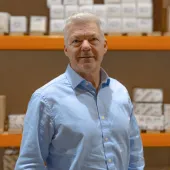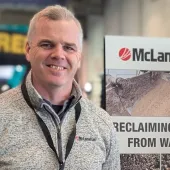Sustainable Asphalt Production

First published in the February 2021 issue of Quarry Management
Dr Hans-Friedrich Peters, executive vice-president of the asphalt and concrete plants division at Ammann, discusses the latest technology and what is on the horizon for asphalt producers
Sustainability has been part of the roadbuilding conversation for decades, yet improvements that make the methods and machines more environmentally friendly continue to gain momentum. Industry leaders increasingly see green practices not only as a way to better the world, but also as a tactic to improve profitability.
Among those at the forefront of such sustainable efforts is Dr Hans-Friedrich Peters, executive vice-president of Ammann’s plants division, who recently provided an in-depth look at how asphalt production has become more sustainable – as well as a glimpse at what is on the horizon.
Conversations about ‘green’ road building always start with the use of recycled asphalt planings (RAP). Do these recycled materials really perform as well as mix made from virgin aggregate?
Yes, the conversation does start with RAP – and so it should. The biggest reductions in indirect CO2 emissions result from the implementation of RAP. We should not categorize RAP as waste material; it is a perfectly fine substitute for virgin materials. The aggregates in reclaimed asphalt show little aging and are mechanically and geometrically within the quality ranges of new material. Bitumen holds up well, too. Its aging is limited and can be compensated by using small amounts of new bitumen.
When utilizing RAP you are saving on both aggregate and bitumen costs – while reducing emissions, initially and over the lifetime of a road. Ammann technology allows the use of RAP percentages up to 100%. In reality, the percentage is usually much less, based on the amount of RAP that is available and the recipes defined by the authorities.
Are countries increasingly adopting recycling, or have we hit a bit of a plateau? And what about the earlier adopters – are they taking further strides or are they content to recycle at existing levels?
Many countries that did not initially adopt recycling are now moving ahead rather quickly. China is an example of this. The country is leveraging some of our most advanced recycling plants and creating mixes with extremely high percentages of RAP.
The earlier adopters are now recycling even more. That can result from governments lifting restrictions, but increasingly it is because the asphalt producers see the value of RAP. Whatever the motivations, the global community is benefitting. From an environmental perspective, all parties involved should increase their efforts to expand the percentage of RAP being used for new pavements.
The challenge with RAP is the heating of the materials. Hot temperatures damage bitumen. In some processes, virgin aggregate is heated, which mixes with the RAP to raise its temperature. But when making mix with 100% RAP, there is no virgin aggregate – and therefore no secondary heat source. How do Ammann plants heat the 100% RAP mix without damaging the bitumen?
On the high end of RAP utilization is the Ammann ABP HRT (High Recycling Technology) asphalt-mixing plant. It can produce mix with up to 100% RAP; no virgin aggregate is required.
There is considerable technology and innovation involved in the HRT concept, in particular the RAH100 counterflow drying process technology. Essential to the RAH100 is its gentle heating process. During the warm-mix process, the dryer heats materials to temperatures between 100°C and 130°C. It also makes asphalt at 140°C to 160°C if a more traditional mix is desired.
The heating is usually where the complications with RAP material arise. RAP must reach its target temperature, but the valuable bitumen will be damaged if the material is heated too quickly. The RAH100 eliminates this concern. It consists of two connected sections. One is a hot gas generator that contains a burner and forces air toward the second section, which is a counterflow dryer.
The RAP enters at the far end of the counterflow dryer section and moves toward the heat chamber. At the end of the counterflow dryer, RAP is transported to an accompanying silo. The heated RAP mix leaves the dryer before the temperature becomes excessive, so it never reaches the critical temperature where the bitumen is damaged.
The ABP HRT is an extremely advanced plant, but Ammann always strive for further improvement, so this system, created more than a decade ago, is constantly being improved. That includes the hot gas generator, which has been upgraded on multiple occasions.
The appearance of the ABP HRT is unique, with the recycling system placed above the mixer. What is the purpose of that design?
The plant is designed around the incorporation of large percentages of RAP. What you see is a nod to the fact that the HRT plant has elevated RAP from a supporting role to the lead actor.
As stated, the most striking difference is that the ABP HRT’s entire recycling system is arranged vertically, in direct line above the mixer. This allows materials to be dropped instead of conveyed, which minimizes wear and optimizes transport of the hot RAP. The HRT approach also means that there is enough room in the plant’s tower for additive feed components and for carrying out inspection and maintenance work.
Making mix that theoretically consists of 100% RAP is impressive. Yet many asphalt producers will utilize lesser amounts of RAP. What are the solutions for these customers?
Many of our customers fall into this category, and we have products for them, too. There are various heating processes that depend on the amount of recyclables. The RAH60 is a parallel flow dryer where up to 60% hot recycled materials can be fed, whilst the RAH50 is a middle-ring dryer that incorporates up to 40% hot recycled materials.
Recycling can take place in Ammann plants without these specific dryers. Up to 30% cold recycled material can go directly into the mixer, meaning almost every Ammann plant is capable of utilizing that amount of RAP.
It would seem that, at some point, there will be little more progress manufacturers can make on emissions. Are there opportunities for further reductions?
There are indeed. The newest is in regards to volatile organic compounds (VOCs). These compounds must be diminished in the clean gas stream to cut the total carbon value.
We continually work to reduce CO2 emissions. This can be accomplished by actively cooling the drum, increasing drying efficiency and utilizing energy sources such as biofuels and wood dust. Ammann technology can diminish CO2 by 10% or even considerably more, depending on the age of the plant and the technology chosen.
There are other somewhat hidden opportunities to trim CO2 emissions, including the bitumen tank farm. A traditional farm consists of horizontal tanks heated with thermal oil. Changing to an electrically heated, vertical tank farm results in considerable advantages. There is no oil consumption and, therefore, no emissions. Electric heating is cost-effective, too. In fact, electrically heated bitumen tanks have become standard in all of Europe and other parts of the world.
There are also other emissions such as dust and odour. Their level of importance and the maximum values being allowed differs greatly from country to country and area to area. Our technology allows the lowest values for all of them (eg <10mg/m3 of dust) without causing any restrictions on the plant operations.
Low-temperature asphalt (LTA) is another opportunity that is becoming more prevalent. While conventional asphalt is produced at around 170°C, the low-temperature processes of today allow production temperatures of around 100°C. Lowering the manufacturing temperature eases energy needs, and therefore emissions, too.
LTA impacts the entire production process – including drying, mixing sequences and recycling. Ammann have focused their research and development on the complete manufacturing process for LTA.
The placement of plants in residential and commercial areas also raises noise issues. Why are plants located in these areas, and what can be done to limit the noise?
A shortage of industrial land means that asphalt plants increasingly must be located closer to residential areas. Local governments can have very strict standards when it comes to noise, so we have to make the plants as quiet as possible.
Ammann have been very proactive on this front. We offer varied sound-suppression packages to meet our customers’ specific needs. Some customers need to lower sound a bit, while others have to take more substantial measures. The efforts start with equipping burners with variable-speed motor drives, which are much quieter, and stack silencers, which control exhaust noise. We offer more and more sound-suppression options, all the way to cladding the entire plant.
Incidentally, that cladding, makes the plants look like commercial buildings. They are beautiful facilities that fit nicely in urban office parks. Passers-by would never guess there is an asphalt-mixing plant inside.
You referenced dust emissions earlier. This is becoming a bigger issue as plants must often be located in sensitive areas. Can anything further be done to limit the dust that results from these plants?
The conversation about dust emissions starts with the baghouse. Ammann asphalt-mixing plants remove dust through a highly efficient baghouse filter. It actually lowers exhaust dust to less than 10mg/m3, which is an exemplary benchmark, and we are currently working on reducing this value significantly again, to less than 5mg/m3.
People often focus solely on the dust resulting from the mix-making process, and what comes out of the chimney. They forget that all the logistical operations around an asphalt-mixing plant, and around equipment like trucks and wheel loaders, are creating much more dust than the plant itself. Fortunately, countries like China, and also some areas in Europe, are increasingly considering these other sources.
Ammann and their customers have together developed solutions to further limit dust. We focus on dust-reduction points for further improvement. Taking measures at the cold feeder, load-out, skip hood, overflow silo, filler loading area, screen, belts and transfer points makes a big difference. That is in addition to the efforts provided through the baghouse.
To summarize the current state of emissions, I would say the main focus is on trimming CO2, VOCs and NOx in the combustion process, and on reducing the residual dust content after the baghouse. There are also markets in which, for example, the integration of pre-dosing into the dedusting process is being promoted.
Are local governmental requirements becoming stricter in general? We discussed CO2, sound and dust emissions, but what about odour – particularly given that the plants are increasingly placed in residential or commercial areas?
Overall, yes, the requirements are becoming stricter – but they are extremely different from one country to the next. We are eager to comply with all the regulations because it is the law and because we want to be good neighbours, too. That means a lot more than shrinking carbon and VOC emissions. It also includes muffling sound, which we just discussed, as well as dust and odour.
In regard to odour…bitumen fumes are the primary source of odour. Ammann offer different solutions to contain the fumes and the odour that can result. As with dust, we have reduction points – in this case the bitumen tanks, the skip and load-out levels and the stack.
There is a great deal of talk about alternative energy sources, including biofuels. But some mix producers who are contemplating a plant purchase might be hesitant to commit to such fuels, as they are somewhat unproven and their availability might not be as consistent as traditional sources.
Ammann biofuel burners can also utilize more traditional fuels such as natural gas, LPG, light and heavy oil and kerosene. This alleviates the concerns of customers who are hesitant to rely solely on newer fuels. The use of these new fuels is another meaningful win on the green front. We are taking renewable energy sources or, in some cases, converting a waste product into fuel. This conserves natural resources and puts less pressure on landfills.
On the renewable front, we are very high on the wood dust burner. The burner transforms wood dust, a material that is available from local sources, into a renewable fuel. What makes this dust burner even more exceptional is its carbon neutrality. The carbon dioxide released when burning wood is offset by the fact the tree consumed that amount of carbon dioxide during its life. Therefore, this part of the emissions is carbon neutral. The burner has proven effective and is utilized on a number of Ammann asphalt-mixing plants. It can be retrofitted on existing plants as well.
Biofuels are another initiative. They support climate protection and reduce dependency on mineral oil. Examples of these fuels are rapeseed and sugar cane. Tall oil, which is a waste product of cellulose sulphate production, can be used, too. We expect that in the near future other fuel types, such as hydrogen, will significantly reduce gas emission values. These fuels will also be much more important in our industry. Ammann are already working on solutions to be prepared for this.
Plant owners might look at these comments and say, ‘These are great ideas, but I already own a plant’. How can an asphalt producer begin to make the change to a greener operation while utilizing their existing plant?
Asphalt producers might be surprised by how much they can accomplish with their existing plant. A very easy first step is to upgrade the control system. A modern control system can have a significant impact on efficiency, and that cuts across many parts of the process. Improved efficiency will lessen fuel usage, emissions and material waste.
Training is another immediate step that can be taken. The best plant and control system in the world will underperform if the operator is unable to leverage the built-in value.
Another option is a more comprehensive retrofit. It still costs a fraction of the price of a new plant and is compatible with products made by Ammann and other manufacturers. A retrofit has a host of options you can choose from, including recycling solutions. A retrofit allows the use of foam bitumen, waxes and other additives. Special bitumen and alternative mixing cycles can be utilized as well.
Again, the plant owner can determine the level of the commitment. Many retrofit customers incorporate a new dryer, which optimizes heat transfer – and of course reduces emissions – and enables the employment of an expanded range of materials, including RAP. A retrofit can include environmental upgrades to the bitumen tank and baghouse. It can incorporate noise-reduction solutions, too. A host of technological improvements can be made – including revamped burners, mixers and the control system.
- Subscribe to Quarry Management, the monthly journal for the mineral products industry, to read articles before they appear on Agg-Net.com








